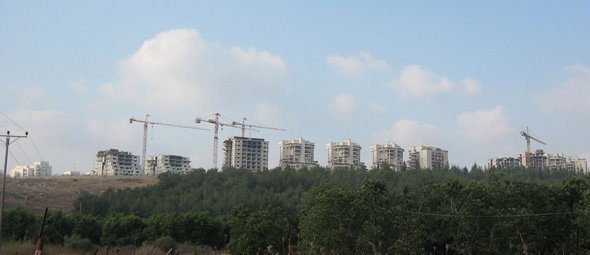Israeli settlements are not only internationally controversial, they are also extremely boring in terms of architecture and urbanism. Far-reaching privatisation and neoliberal politics are partly responsible, says Gabriel Schwake. No wonder people live in soulless block boxes elsewhere as well.
In the area where the Trans-Israel Highway ('Highway 6') connects the north and south of the country, settlements have been springing up like mushrooms since 1977. It started as a purely governmental operation, but from the mid-1980s the Israeli state has left the expansion to the market. Even the construction of the highway, which runs close to the border with the occupied West Bank, was a private job: market parties who financed the construction are now charging tolls. "It is remarkable that the Israeli government is leaving a matter of geopolitical importance - settlement policy - to private parties," says Schwake. "Although this is considered a neoliberal approach, there is no question of less state influence. On the contrary, it has been strengthened.
Quality-of-life settlers
The settlements along the central thoroughfare are not the strongholds of fanatical settlers, such as deeper into the West Bank or - in the past - the Gaza Strip. They are partly on the Israeli side of the border and bear more resemblance to the suburban neighbourhoods in which the American or Dutch middle classes live. And that is precisely the market segment for which they are being developed: moderate, secular middle groups. "Quality-of-life settlers", is how Schwake describes them. The first residents were mainly people with good connections - via trade unions, the army or political parties - and the population was very homogeneous. When large companies took over the construction, the Ministry of Housing gave clear guidelines about the desired population. They wanted more middle class, so advertisements for the projects were only allowed in two quality newspapers. Expensive low-rise buildings were built first, to attract the wealthy bourgeoisie, the rest would follow naturally - even if they were cheaper flats.
Schwake, who himself worked as an architect and urban planner in Israel, was surprised by the poor quality of the architecture. Consumer-oriented solutions don't make it there, buyers have no influence on the appearance of their future home. Neither do the architects, they simply have to deliver the drawing for a plan that is fixed. Why is this? Because for the developers and builders involved, profit maximisation is paramount, he believes. If that can be done with little effort, that is preferable. "People will buy anyway, particularly since the 2008 credit crisis," says Schwake. "Buying a house is a safe investment. What counts is the number of square meters and in any case there is hardly any choice".
Where houses are built is a matter of geopolitical considerations in Israel; the government is uses them to consolidate annexations. The way in which they are built determines the market, within the restrictions set by the state. In addition, the government maintains control by giving only a few large corporations the right to develop the sites. And that encourages standardisation, Schwake observes, because uniformity is the easiest way for market parties to make a profit. "It's the same method that jeans manufacturers use to sell their products worldwide. Uniformity is easily accepted in Israel because a national style of building is lacking. After all, it is an immigrant country without a culture that has grown over the centuries.
Fragmented land distribution
So is this a typical Israeli problem? Certainly not. A terraced house in the Netherlands may be different from that in Germany, but the 'home' of an average citizen of a country looks exactly the same as that 'safe haven' in which fellow citizens live. Look at the VINEX out-of-town neighbourhoods built in the Netherlands since 1995.
According to Schwake, the only way to change the depressing dullness in housing construction is for policymakers to break the monopoly of the large market players. In other words: to ensure fragmented land distribution and to actively promote the entry of small developers who focus on the wishes of residential consumers. "If you let one party build a thousand homes, they will all look more or less the same. One hundred developers will deliver one hundred different types of homes and provide real choice. That is socially sustainable development.
